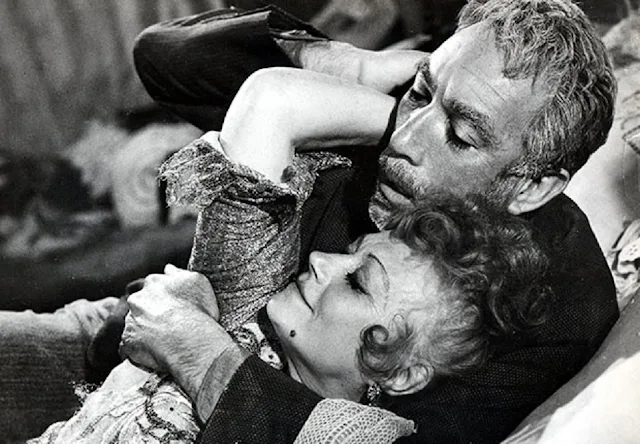 |
| Chieko Higashiyama and Chishu Ryu in Spring Dreams |
Miss Yasugi: Yoshiko Kuga
Shobei Okudaira: Eitaro Ozawa
Shinichiro Atsumi: Chishu Ryu
Grandma: Chieko Higashiyama
Miss Yae: Michiko Araki
Tamiko Okudaira: Yatsuko Tan'ami
Mamoru Okudaira: Yusuke Kawazu
Dr. Hanamura: Shuji Sano
Eiichi Kato: Shinlji Tanaka
Ema: Miki Mori
Haruko: Mie Fuji
Kimiko: Meiko Nakamura
Umeko: Yukio Toake
Director: Keisuke Kinoshita
Screenplay: Keisuke Kinoshita
Cinematography: Hiroshi Kusuda
Art direction: Chiyoo Umeda
Film editing: Yoshi Sugihara
Music: Chuji Kinoshita
Keisuke Kinoshita's attempt at something like screwball comedy, Spring Dreams, has been likened to Jean Renoir's Boudu Saved From Drowning (1932) because of its premise: a member of the lower classes throws a self-centered middle class household into chaos. In this case, it's a sweet potato vendor who has a stroke in the living room of the Okudaira household and is forced to recuperate there. Because most of the action takes place in a few rooms in the Okudaira house, I'm more reminded of the stage comedies of George S. Kaufman and Moss Hart, The Man Who Came to Dinner and You Can't Take It With You, especially since Kinoshita films with long "theatrical" takes. The head of the household, Shobei Okudaira, is an irascible would-be tyrant, bullying and mocking not only his family but also his secretary, Miss Yasugi, taunting her as an old maid. The workers of his pharmaceutical company are threatening to strike as the film begins, so he has a lot to bluster about. In true comic fashion, there are romantic problems to solve -- Shobei's daughter Chizuko wants to marry an artist, while he wants her to marry the son of one of his executives, if only to provide a suitable heir for his business. His own son, Mamoru, is a nerdy would-be philosopher who goes about inquiring into the meaning of life and has no interest in the business or much of anything else. (He's played by Yusuke Kawazu, unrecognizable as the same actor who played the rebellious Kiyoshi in Nagisa Oshima's Cruel Story of Youth, made the same year.) In the course of the film, the spinster Miss Yasugi will also find love, and even the matriarch of the household, Okudaira's mother-in-law, will recognize the sweet potato vendor as the lost love of her youth -- they're played, incidentally, by Chieko Higashiyama and Chishu Ryu, the elderly couple of Yasujiro Ozu's Tokyo Story (1953). Chuji Kinoshita's harpsichord score lends a delicacy to a film with a good deal of charm.









